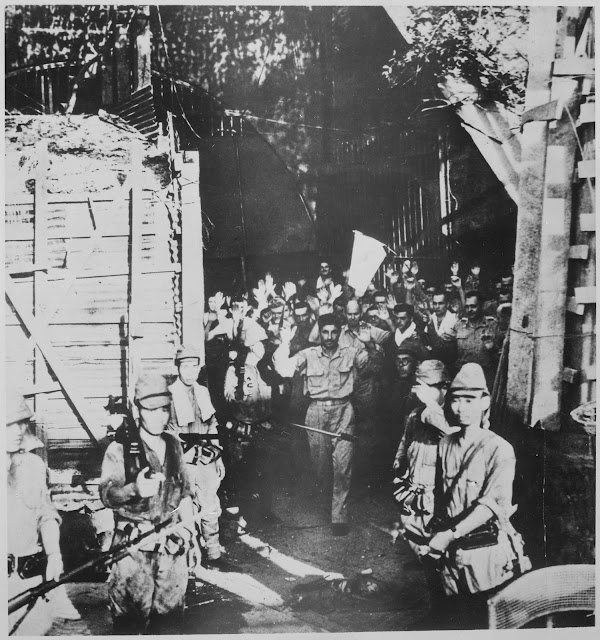Image size: 1600 x 1177 pixel. 509 KB
Date: Monday, 18 September 1944
Place: Arnhem, Gelderland, Netherlands
Photographer: Sergeant D.M. Smith
Four of the five prisoners of the SS-Panzer-Aufklärungs-Abteilung 9/9.SS-Panzer-Division "Hohenstaufen" (one is a seventeen years old. All of them are wearing the pea dot 44 camouflage pattern (SS-Erbsenmuster) that were peculiar to the Waffen SS) shortly before being handed over to the Military Police, captured during Viktor Graebner's ill-fated attempt to rush through the British defences around Arnhem Bridge on the morning of Monday, 18th September 1944. The three guards in the background are glider pilots (!), from left to right, Staff Sergeants Joe Kitchener, "Duffy" Edwards, and George Milburn. Upon arriving in the Arnhem area, the 9th SS Division began the task of refitting. The majority of the remaining armoured vehicles were loaded onto trains in preparation for transport to repair depots in Germany. On Sunday, 17 September 1944, the Allies launched Operation Market-Garden, and the division would become heavily involved in the subsequent Battle of Arnhem. The British 1st Airborne Division was dropped in Oosterbeek, to the west of Arnhem. Realizing the threat, SS-Obergruppenführer und General der Waffen-SS Wilhelm "Willi" Bittrich (commander of the II. SS-Panzerkorps) ordered 9.SS-Panzer-Division "Hohenstaufen" (led by SS-Oberführer Walter Harzer) and 10.SS-Panzer-Division "Frundsberg" (led by SS-Brigadeführer und Generalmajor der Waffen-SS Heinz Harmel) to ready themselves for combat. The division's armour was unloaded from the trains and workshop units worked frantically to replace the tanks tracks, which had been removed for transportation. Of the division's armored units, only the division's reconnaissance battalion; equipped mostly with wheeled and half tracked vehicles, was ready for immediate action. Bittrich ordered "Hohenstaufen" to occupy Arnhem and secure the vital Arnhem Bridge. Harzer sent the division to the city, encountering stiff resistance from the "Roten Teufel" (Red Devils), as the Germans came to call the British paratoopers. The Reconnaissance Battalion, a 40-vehicle unit commanded by Hauptsturmführer Viktor Eberhard Gräbner, was sent south over the bridge to scout the area around Nijmegen. Gräbner had that day received the Ritterkreuz des Eisernen Kreuzes (Knight's Cross of the Iron Cross) for his actions in Normandy. While the Reconnaissance Battalion was scouting to the south of Arnhem, Colonel John Frost's 2nd Battalion of the British 1st Airborne Division had advanced into Arnhem and prepared defensive positions at the northern end of the bridge. Gräbner returned from his scouting mission to the south on the morning of 18 September, and ordered about half of his reconnaissance unit, numbering about 22 armored cars, half-tracks, and a few trucks, to attack north across the bridge. Gräbner's exact intentions remain a mystery, but he apparently either hoped to recapture the bridge or to race through the British defences to assist the rest of the division in its defence of Arnhem. Either way, the attack was a complete disaster. The Paras were ready, and after allowing the first four vehicles to pass, they opened up with PIAT anti-tank launchers, flamethrowers and small arms fire. In two hours of fighting, the Reconnaissance Battalion was virtually annihilated, losing 12 vehicles out of 22 in the assault and around 70 men killed, including Gräbner. This action is depicted in the film "A Bridge Too Far". Throughout the eight-day battle, the division operated mostly in and to the west of Arnhem, fighting with Frost's battalion and reducing the pocket containing the remainder of the 1st Airborne, which had become encircled near Oosterbeek. The battle of Arnhem was a victory for Hohenstaufen. With the assistance of other German units, the division had destroyed an elite British airborne unit, which was badly outnumbered and only lightly armed. Despite the intensity of the fighting, the soldiers of Hohenstaufen and Frundsberg treated the captured paratroopers courteously, although there are reports of cold-blooded executions by some SS members, and Bittrich remarked that the tenacity and fighting prowess of the Red Devils was not to be matched, even by the Soviets!
Source:
http://commons.wikimedia.org/wiki/File:Waffen_SS_snipers.jpg
http://www.iwm.org.uk/collections/item/object/205192037
http://www.pegasusarchive.org/arnhem/Photos/PIcSSPow.htm






+and+Hermann+G%C3%B6ring+(1893-1946).jpg)

























+is+Abandoned.jpg)

,+Leutnant+Erwin+Fleig,+Hauptmann+Heinz+B%C3%A4r+and+Hauptmann+Heinrich+Krafft.jpg)
